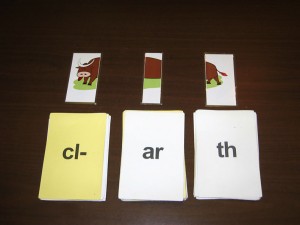Silly Bulls provide a visual representation of how syllables are segmented into beginning, vowel and ending sounds. By using the Silly Bulls throughout the entire lesson, students can begin to understand that they are taking apart and putting back together the same parts for recognition and naming, blending, sounding out and spelling.
For the Blending Drill, use the individual Silly Bull head, body and tail cards to associate with the beginning, vowel and ending phonics card piles. This is a great first step in helping students become familiar with what we mean when we want to refer to a syllable’s beginning, vowel and ending sounds.
They can see that the cards in the first pile (consonants and initial blends) correspond to the Silly Bull head, which is the syllable’s beginning sound. Likewise, the vowel sound is always associated with the Silly Bull’s body. Consonants and ending blends after the vowel are the ending sounds, which go with the Silly Bull’s tail.
Note that a syllable does not always have to have a head (such as “and”), and a syllable does not always have a tail (such as “play”), but it will always have a body (because of course a syllable always has a talking vowel, which is the middle pile in the blending drill). If you ever get confused about this, simply think about which pile the cards would be in for the blending drill, and then look at how the body parts match to the corresponding piles!
This post is part of a series of articles on how to get the most out of your Silly Bull Kit:
Silly Bulls: head-body-tail segmentation
Silly Bulls and the Blending Drill (you are here!)
Silly Bull Syllable Type Cards
Silly Bulls and Introducing New Concepts

